| Main page » Polish armour » armoured trains » Nr. 15 – Polish artillery – Steel Panthers – what's new |  |
||
| © Michal Derela, 1999 | Updated: 22. 10. 2021 | ||
| Main page » Polish armour » armoured trains » Nr. 15 – Polish artillery – Steel Panthers – what's new |  |
||
| © Michal Derela, 1999 | Updated: 22. 10. 2021 | ||
Early history - Combat use in 1939 - Description
 |
| Armoured train "Śmierć" in its composition from 1930s, in new camouflage (circa 1937). A locomotive is Ti3-8 of the same class, from the train "Paderewski" for photo session. |
By the end of October 1918, the Great War was rapidly coming to an end, while the Austro-Hungarian Empire and army were disintegrating. Newly constituted Polish authorities started to gather Polish territories back from over century-lasting German and Austrian occupation, and gain arms from them to defend the independence. One of the most valuable acquisitions was a whole Austro-Hungarian armoured train, captured by the Polish underground military organization. It was next used by Poland in wars against Western Ukraine, the Soviet Russia and in World War II.
Description and history of original armoured train "Śmierć" in 1920–1929 is in part I.
Note: links marked this way lead to relevant Wikipedia articles.
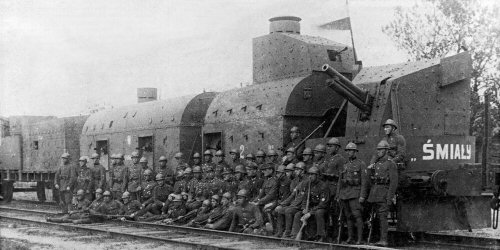 |
| P.P.2 "Śmiały" in 1920 – this artillery wagon (here with 8 cm M.5/8 gun) and infantry wagon will be later found in the "Śmierć". It is interesting to compare the wagons with later incarnations. [3] |
 |
| Austro-Hungarian armoured train in the strongest form (type B). Drawing: V. But (combined, with infantry wagon type 2 from single-locomotive trains) |
The Austro-Hungarian army employed at least twelve regular armoured trains during World War I. Most of them – eight, consisted of standard type armoured stock, but their detailed composition differed. Except for two strongest trains with two artillery wagons and one infantry wagon, hauled by two locomotives, most trains had only one artillery wagon and one or two infantry wagons, or sole two infantry wagons, although their composition was changing with time.
By the end of the war, the rolling stock of the 3rd Armoured Train Detachment (3 k.u.k. Panzerzug Abteilung) was seized at Kraków-Prokocim station in Kraków (Cracov) by the underground Polish Military Organization (POW) on 1 November 1918. The captured train was a mix of k.u.k. Panzerzug (PZ) III and VIII in their late composition – with one infantry wagon originally coming from the PZ.I and another from the PZ.IV. Older publications claimed, that it was Panzerzug V or "type V" train, which was not correct. It consisted of two armoured locomotives series 377, two standard type artillery wagons and two (or three) standard infantry wagons[note 1]. On 3 November 1918 the train was manned by the Polish crew, and soon divided into two trains: P.P. 1 "Piłsudczyk" and P.P. 2 "Śmiały", which became first regular armoured trains of the Polish Army (even preceding officially acknowledged date of Polish independence, 11 November 1918). Each train was given one locomotive, one artillery wagon and one infantry wagon, and then was completed with further Polish-built improvised armoured wagons. Both trains were at once moved to Przemyśl and Lwów (Lviv), in order to defend these cities against Ukrainians [note 2].
Both "Śmiały" and "Piłsudczyk" fought in Polish-Ukrainian war 1918-1919 and Polish-Soviet war 1919-1920. In 1921 both trains were equipped with modern twin-turret artillery wagons of Polish design (type III). Old Austro-Hungarian artillery wagons of "Śmiały" and "Piłsudczyk" and the infantry wagon of "Śmiały" were given to armoured train "Zagończyk" (P.P. 12). After disbanding of "Zagończyk" in 1929, its three ex-Austro-Hungarian wagons were assigned to the armoured train "Śmierć", being a subject of this page. The other infantry wagon served in "Stefan Czarniecki" armoured train (P.P. 8), also disbanded in 1929, and finally in "Pierwszy Marszałek". A final composition of Polish armoured trains, with minor changes, was established in 1930.
Original armoured train "Śmierć" (P.P. 23) was created in August 1920 in Kraków, to compensate for units lost during withdrawal [note 3]. Its wagons were built there upon German open freight wagons. It took part in the final stage of Polish-Soviet war, until a truce in October, and then in operation of occupying Vilnius, under a pretext of Gen. Żeligowski's "mutiny". After the war, the "Śmierć" was among only twelve trains assigned in June 1921 for further service. Since 1924 it was in reserve, with new number 4 (P.P. 4). In 1927, still in reserve, the "Śmierć" got its final administration assignment to the 1st Armoured Train Unit (1. Dywizjon Pociągów Pancernych) in Legionowo near Warsaw.
During last major reorganization of Polish trains in January 1930, their number was reduced to ten, and the "Śmierć" received its classic composition, of three ex-Austro-Hungarian wagons from the "Zagończyk": two artillery wagons (141164 and 141455) and the assault wagon (390243). In late 1920s and early 1930s, the train's stock underwent several modernizations, like other Polish trains. It received radio and signal equipment and Westinghouse pneumatic brakes.
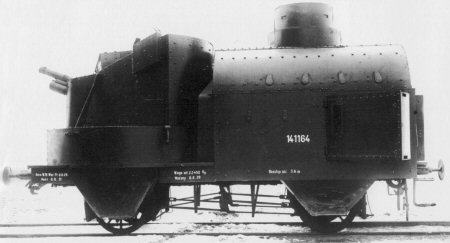 |
| Early photograph of modernized 114164 wagon, dated 1929 year. |
By the end of 1920s the Austro-Hungarian artillery wagons were rebuilt, their armament was standardized (75 mm wz. 02/26 cannons and 7.92 mm wz. 08 machine guns) and they received anti-aircraft machine gun turrets instead of obsolete fixed superstructures. In early 1930s the armoured locomotive was changed to Ti3-5 of new standard Ti3 (G53) class. In late 1930s the train received a standard three-color camouflage. It had not been brought back from reserve to active service before a mobilization in 1939. However, on contrary to the majority of Polish trains, a composition in which the "Śmierć" went to another war, differed from previously established one.
In August-September 1939, during a mobilization, the 1st Armoured Train Unit formed five trains, among them armoured train Nr. 15 of former stock of the "Śmierć" (the names were not used anymore officially). According to a plan, it was to be ready on the third day of the mobilization. For many years it was believed in publications, that the train Nr. 15 was still composed of two Austro-Hungarian wagons armed with single 75 mm cannons, and one assault wagon of the same origin, like on the official title photograph. Such version was also initially present on our page. Only recently it has been researched and confirmed with photos, that during the mobilization, one of the original artillery wagons was replaced with an other artillery wagon armed with a 100 mm howitzer to strengthen its firepower (no. 430047).
It might be noted, that a presence of the howitzer wagon was first mentioned in little-known article by J. Magnuski in 1989[6], but he claimed, that it was given in addition to two original artillery wagons, and its look was not known by then. The photographs of the howitzer wagon were published for the first time for wider public on our page in 2004, shortly after they had appeared on auction portals and Internet forums. Further research revealed, that the howitzer wagon replaced one of original artillery wagons (153 650, ex 141 455), and the train retained a typical prescribed composition of Polish armoured trains, with only two artillery wagons[10]. In addition, there are no photographs of the captured train that would show its both original wagons. A fate of the second artillery wagon is not known – it might have been included into the evacuation train of the 1st Armoured Train Unit in September 1939, which reportedly had one unidentified two-axle artillery wagon, unfortunately without ammunition. The train itself was abandoned near Siedlce on 12 September.
"Śmierć" means "Death" in Polish. It may be pronounced in English like: [shmy-air-tch], but softer.
 |
| The train Nr.15 at Modlin station, captured by the Germans. Visible is new howitzer wagon, the locomotive and the cannon wagon, with a flatcar behind. |
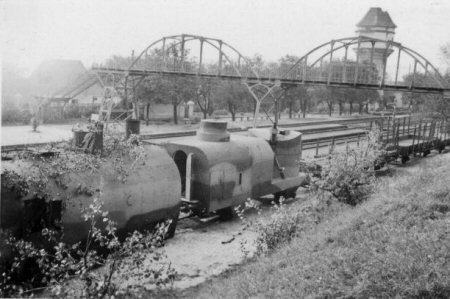 |
The armoured train Nr. 15 was commanded by Cpt. (kapitan) Kazimierz Kubaszewski. The train was initially at Polish C-in-C disposal. It completed its mobilization in Legionowo only on 4 September 1939, then was assigned to the Army "Modlin" (deployment map). During the next day, the train operated on a line Nasielsk – Ciechanów, and along with the train Nr.13, appeared very useful, fulfilling reconnaissance duties and providing the Army staff with situation reports. One of its armoured draisines Tatra was destroyed that day by AT-guns during a patrol near Nasielsk town.
From 8 September the train was subordinated to Modlin fortress Defence HQ. On the next day, due to damaged bridge on the Bugo-Narew, the armoured train lost contact with its administrative section, and had to operate without it (the administrative section rode to Legionowo, then to Warsaw afterwards). When German siege of Modlin started, from about 15 September, the train was used as a mobile artillery in the fortress area, manoeuvring on a several kilometer track between Modlin and Pomiechówek stations. It was assigned to support the 1st battalion of the 32nd Regiment of the 28th Infantry Division, holding Pomiechówek area. The train appeared quite efficient in supporting Polish defenders, firing at pointed targets and helping to repel enemy attacks. On 19 September it was even fighting an artillery duel with its German adversary – armoured train Panzerzug 7[note 3], acting on Nasielsk – Pomiechówek track. On 22 September it supported Polish II/36 battalion in a successful night counter-attack near Pomiechówek, which repelled the enemy from a right bank of the Wkra river.
During the next days, the train was not used that much due to enemy artillery superiority and ammunition shortages in the fortress. The train was mainly staying in a railway track excavation near "Ostrołęka" fort at that time. On 25 September the assault wagon was hit by enemy artillery and got burnt. Also the locomotive was damaged and reportedly replaced with a regular one. Photos taken by the Germans after the siege show the train with the armoured locomotive, however, although fire-damaged (it might have been set on fire during surrender, or the whole train could have been moved by external locomotive, which however is not visible on the photos). Finally, on 29 September, the lonely fortress surrendered as one of last points of resistance in Poland. The crew destroyed the train's armament then. The train Nr.15 was the last Polish fighting armoured train. For unknown reasons, it was not used by the Germans after its capture, although they impressed into service seized Czechoslovak trains with the same Austro-Hungarian wagons.
Main source: [2]
 | The locomotive Ti3-5 with fire-damaged driver's cab and the howitzer wagon. |
The armoured train Nr. 15 consisted of:
| Drawing: A. Jońca | |||||
 | |||||
| flatcar | artillery wagon | armoured locomotive | assault wagon | artillery wagon | flatcar |
A length of a whole armoured part (including flatcars), with two original artillery wagons, was 69 m (226 ft), weight: 215 t[5]. The "Śmierć" was a light armoured train, so the armoured section's crew was presumably only about 80 men. The whole armoured train's crew was probably up to 155. From around 1936–37, the train was painted in a standard three-color camouflage of Polish vehicles, consisting of brown-green and dark brown irregular patches, airbrushed upon a greyish sand basic color. The patches were oblong, mainly horizontal. There is not known a camouflage in 1920s – at first the trains were camouflaged with unknown patterns, later they were in an uniform colour (gray or green). Originally, captured Austro-Hungarian wagons were light gray.
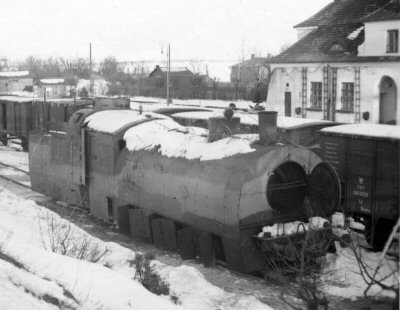 |
| The locomotive Ti3-5 in Modlin in winter. [collection of A. Przeczek] |
The armoured train, as a military unit, consisted of: an armoured section, a platoon of armoured draisines and an unarmoured auxiliary section. The armoured section and armoured draisines were the combat section of the armoured train, while the auxiliary section was supporting the operation of the combat section in respect of logistics and accommodation, and did not take part in combat.
The standard locomotive of Polish armoured trains in 1939 was the armoured steam locomotive PKP Ti3 class - former Prussian G5³ class, produced between 1903 and 1906 and fitted with a typical full armour in Poland. From early 1930s, until 1939, the "Śmierć" used locomotive Ti3-5 (former G53-4025 Danzig), manufactured in 1904 by Hanomag, factory number 4118. It was coupled with a typical three-axle tender 12C1 class (unknown number).
Upon the tender, there was a commander's turret. It was equipped with a short-range radio RKB/C to contact the draisines, and an intercom to contact the wagons. It also had optical and sonic means of internal communication (color lights, bells and horns). A maximum speed of a locomotive with armoured wagons was about 45 km/h (28 mph). The armoured part was equipped with Westinghouse brakes by 1930s.
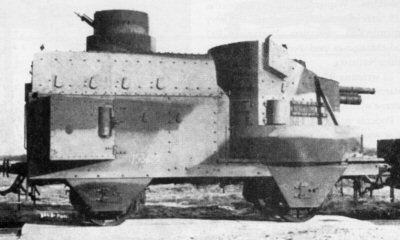 |
| Modified artillery wagon 153 650 in late 1930s. |
 |
| Turret of the wagon 141 164 captured by the Germans in Modlin |
In the 1930s, armoured train "Śmierć" had two two-axle artillery wagons of the standard Austro-Hungarian type, built by MAV railway workshops and MAVAG factory in Budapest. Only five such wagons were built in 1915–1916, though. Their original numbers were 141 164 and 141 455 (the later was next changed in Polish service to 153 650). Both were initially used in Austro-Hungarian Panzerzug VIII, and the wagon 141 164 later in Panzerzug III. In Poland they were used in armoured trains "Piłsudczyk" (141 455) and "Śmiały" (141 164), then both in "Zagończyk". In late 1920s they were modernized.
Each wagon was armed with one cannon in a turret at one end. The turret was wedge-shaped, built around a naval pedestal gun mounting. Horizontal angle of fire was about 240°. There was a central hatch in rear turret's rounded wall. At the beginning of the service, the wagons were armed with 7 cm (66 mm) SFK L/30 naval guns, replaced in 1920 with Austro-Hungarian 8 cm (76.5 mm) M.5/8 L/30 field guns. By 1925 they were replaced with Russian 76.2 mm M.1902 L/30 Putilov field guns. Eventually in late 1920s or early 1930s they were changed to Polish 75 mm wz. 02/26 L/30 guns (modified Putilov guns), using typical French ammunition. Soon after fitting of Putilov guns, masks of the guns were lengthened (not at the same time).
Other armament consisted of two 7.92 mm wz. 08 (Maxim) machine guns in drum mountings in side doors. With partially open doors, the machine guns could flank-fire towards train's ends (a photo). It was Polish improvement of original wagons – first they had simple casemates for Russian Maxim or Schwarzlose machine guns in the sides, and a door was in rear end wall only. Also in late 1920s there was added one 7.92 mm wz. 08 anti-aircraft machine gun in a small turret on the roof, replacing an original high angular superstructure with one MG fixed towards the wagon's front and an observation cupola above. Maximum elevation of the AAMG was 90°. The ammunition carried in the wagon was presumably 3750 rounds per each MG (in 250-round belts) and 120 artillery rounds per gun, like in other Polish trains.
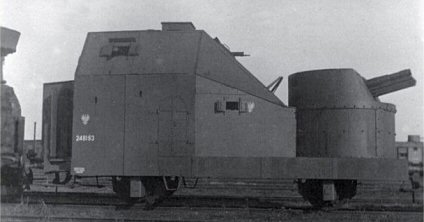 |
| The howitzer wagon 248 193 of Lviv type in an original form in 1920-21. |
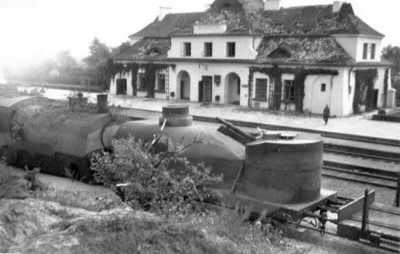 |
| The howitzer wagon of the train Nr. 15 at Modlin station, captured by the Germans. [collection of Arthur Przeczek] |
- a color drawing of an original wagon in "Śmiały"[3]
- a drawing of a modified wagon[4]
The wagons had no armour plating in fact, but were protected with 12 mm regular steel plates. Since Austro-Hungarian Army found the design too vulnerable to machine gun bullets, the protection was strengthened from the inside with 40 mm oak wood layer and the second layer of 9 mm sheet steel, which proved quite enough against machine gun bullets and splinters[3].
The wagon's length with buffers, according to original plans, was 753.6 cm[11] (publications quoted 755 cm[1] or 790 cm[3]); axle span was 360 cm; weight was about 21 tons. The crew was about 12-15 men[3].
During the mobilization in 1939, the train Nr. 15 was equipped with a howitzer-armed artillery wagon number 430 047, replacing the wagon no. 153 650. It was two-axle, built in summer 1920 in Lwów (Lviv), according to Polish design by KBPP Lwów armoured train construction management. It was completely rebuilt afterwards, retaining its configuration with a single turret at the end, but changing its look (its superstructure was made lower and fitted with a rounded roof instead of angular one). Probably it was a wagon with former number 248 193, used in the train P.P. 1 "Piłsudczyk" in 1920-21, then remaining without an assignment until late 1930s[note 4]. Probably it was built upon German open freight wagon Omku (or Ommku) class, with 450 cm axle span and 860 cm frame length[10].
The wagon was armed with one 100 mm wz. 14/19A howitzer in a turret, rotating at 360°. Initially it had Russian 122 mm M.09 howitzer. Other armament in final configuration consisted of two 7.92 mm wz. 08 Maxim machine guns in drum mountings in the sides and the third anti-aircraft wz.08 MG in a typical turret on a roof. There is no information about its armour – it was similar to other Polish armoured trains, probably made of thick boiler steel.
 |
| Assault wagon with Polish modifications and camouflage in late 1930s. [1,4] |
The assault wagon (Polish nomenclature) was intended for a transportation of an assault platoon. The two-axle assault wagon of the "Śmierć" was an original Austro-Hungarian infantry wagon, rebuilt in Poland in the 1930s. Its original number was S150 060, later changed in Polish service to 390 243. There were three types of such infantry wagons, this one (Type 2 according to W. Sawodny) initially had a central water tank for a locomotive inside and a coal box under chassis. It also had an observation cupola, placed asymmetrically, closer to one end. During the modernization, four hollow casemates for machine guns in sides were replaced with flat armour plates with Polish drum MG mountings, and small two-leaf door was cut in each side, near one end. Earlier the wagon had doors in its end walls only. It may be assumed, that the water tank was removed. On contrary to the other such wagon in Polish service (in Nr.51 "Pierwszy Marszałek" train), it was not fitted with opening side sponsons, and lost its observation cupola. This wagon was first used in Austro-Hungarian armoured train Panzerzug I, then Panzerzug VIII, then in 1918–1921 in the train "Śmiały", and then until 1929 in "Zagończyk".
The wagon's armament was four 7.92 mm wz.08 MG's in the sides. The ammunition was probably 3,750 per MG (in 250-round belts). The wagon had also numerous loopholes for rifles in sides. In Type 2 wagons there were nine loopholes in rounded roof edges on each side, with two middle ones placed higher (above the original water tank). There were also two loopholes in walls outside of MG casemates (one was removed, when door was made) and seven loopholes in end walls (five above). The armour was similar to artillery wagons. The assault platoon consisted of 32 men (1 officer, 7 NCOs, 24 soldiers, with 2 LMGs). A total wagon's crew was about 40 (with signalmen and stretcher-bearers).
It might be added, that Type 1 infnatry wagon (as in "Piłsudczyk" train) had ten loopholes in one line in rounded roof edges, two loopholes in walls outside of MG casemates and three between them. Type 3 infantry wagon had MG casemates moved closer to ends in side walls (it carried water and coal for two-locomotive trains – only two such wagons were built, later found in Hungarian No. 101 train and Czechoslovak No. 2 train).
In late 1920s or early 1930s, the assault wagon was equipped with Polish long-range radio RKD/P, placed in a separate radio cab in the middle of the wagon. The radio had maximum range 50–80 km with telegraphy (probably well below 20 km with voice transmission). The wagon was also fitted with a power generator, batteries, and a large clothesline aerial on the roof with two rows of five masts (differing from the wagon in "Pierwszy Marszałek" train, which had three rows of masts).
The wagon's length with buffers was 785 cm according to plans (or 753.6 cm according to less detailed plan), axle span - 360 cm, height up to the roof - 321.1 cm[11].
- a drawing of a modified wagon[4]
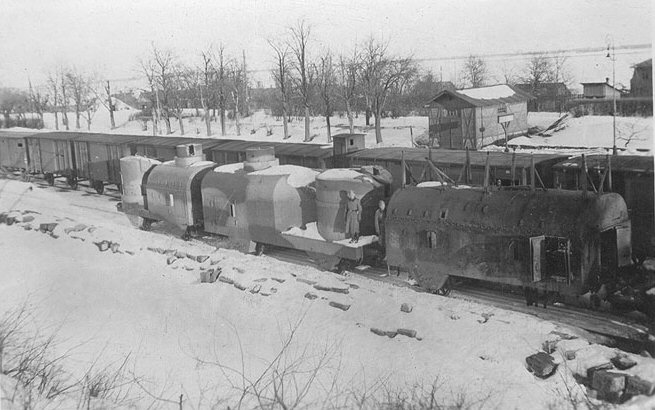 |
Burned out assault wagon, with a damaged axle, and both artillery wagons, laid up in Modlin, winter 1939/40. |
On both ends of the armoured train there were two two-axle flatcars. Their primary function was to carry engineering materials for track repairing (tools, rails and sleepers, logs, explosives etc.). In order to carry 12-metre rails, long flatcars Pdks series were adapted as a standard. Their second purpose was to protect the train against mines or a derailment. There could also be carried eg. bicycles or scout motorcycles (part of the equipment was carried on the auxiliary train's flatcars). During march, there could be an observer upon the flatcar, operating braking valve.
The standard flatcar was Pdkz series, type C VIII, of Polish manufacture (otherwise designated as Pdks series on railways). Its weight was 10 tons, load capacity – 17.5 tons, frame length – 13 m, length with buffers - 14.4 m, wheelbase – 8 m. Special flatcars for armoured trains were modified by fitting three full-width boxes for tools underneath a chassis and 22 lockers for small parts in the chassis. Such modified flatcars had 12 stub stanchions and only one short end wall. There were not enough of military flatcars available, and Nr.15 train had only one modified flatcar and the second standard one, delivered by the Polish State Railways (PKP) during the mobilization[10]. It should be noted however, that the photographs of the captured train don't show the modified flatcar, and the flatcar coupled to the cannon wagon seems shorter, than Pdks series.
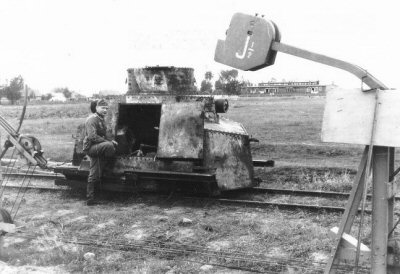 |
| Tatra draisine of the train Nr.15 destroyed on 5 September 1939 near Nasielsk. |
Each Polish armoured train in 1939 had a platoon of armoured draisines (scout rail vehicles). The train Nr.15 had non-standard platoon of only two older draisines Tatra.
Each armoured train, considered as a military unit, also included an unarmoured administrative or auxiliary section. The auxiliary section accompanied the combat section in operational movements and provided it with an accommodation and logistics support. It was manned by a platoon consisting of 1 officer, 21 NCO's and 26 soldiers. The length of the auxiliary section of the train was about 250 m (820 ft).
The auxiliary section consisted of: a locomotive, coaches for officers (2), wagons for NCOs (2) and soldiers (8), bureau wagon, ammunition wagons (2), fuel store wagon, technical store wagon, ambulance wagon, kitchen wagon, workshop wagon, open coal wagon, water tanker and flatcars (5) - some 27 carriages in all[2]. According to other sources there were only 3 flatcars, but also non-regulation food store wagon and sometimes guard wagon[10]. The coaches were three-axle Dy series, the wagons were by default two-axle adapted boxcars Kd series.
The auxiliary section also should have two wz.34 half-tracked trucks, one truck and four heavy motorcycles with sidecars CWS M-111 – carried upon three flatcars, although actual composition differed and might have contained other cars, like Polski FIAT 508/III field cars and pick-ups. Typical Polish truck was 2.5t Polski FIAT 621L (4x2). Wz.34 half-tracks were in the repair patrol, and they could be equipped with a rail-riding device, although they seem rather rare and it is doubtful, if the train Nr. 15, mobilized in last group, had any.
Notes:
Sources:
Updated:
Our Thanks to Jarkko Vihavainen, Jerzy S. Prajzner, Arthur Przeczek.
Main page – Polish armour – Polish artillery – Steel Panthers – Contact
All photos and pictures remain the property of their owners. They are published in non-commercial educational and research purpose.
Text copyright to Michal Derela, © 1999-2021